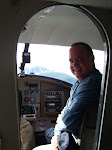 We've got a house full right now. All the kids are home from college. My son's roommate came with him, and my in laws are here for Thanksgiving. It's a little stressful. The good thing is that when I offer to take a carload of them with me, my wife has no problem with flying. Suddenly she fully supports it.
We've got a house full right now. All the kids are home from college. My son's roommate came with him, and my in laws are here for Thanksgiving. It's a little stressful. The good thing is that when I offer to take a carload of them with me, my wife has no problem with flying. Suddenly she fully supports it.My son's room mate is an aeronautical engineering student at Georgia Tech. He works for a company that rebuilds airplane parts and he wants to fly himself one of these days. Well, we were going to the airport anyway so I called early this morning and scheduled a discovery flight for him. I got home from work and told him I had some good news and some bad news. The bad news is that you're not flying with us today. The good news is that you get to pilot an airplane today. The picture at the top is him in one of the 172 G1000s. My son rode along in the back seat and took pics and video. I think seeing the look on his face when he got out of the plane was more fun than anything else we did today.

While they were up, I preflighed good old N54058, none of that fancy G1000 stuff for me, no sir. That's me and my flying guests to the right. When Drew and John landed, it was my turn to play pilot. I took Drew and his fiance, Aubrey, up first. Aubrey is not real sure about small airplanes. The first thing she said when we got to Whitted was "Those are smaller than anything I've been in before." I was on my best piloting behavior. Fortunately, the weather was beautiful. We had very little turbulence, even over St. Petersburg. We flew out to the beach, south to Egmont Key and back to Albert Whitted. We were cleared for a straight-in approach to runway 7, but someone in the pattern extended his downwind too far and we had to circle on final before we were cleared to land. First time that has happened to me.
 Next I took my daughter Sarah and her grandfather up for a spin. This time we flew south to Egmont Key, then over the bay to the Sunshine Skyway bridge. Sarah and Drew took a bunch of photos and some video. I've added to my slide show and have one of the flight videos available on the blog. Sarah also took my favorite shot, only a pilot would like this one, my turn onto final for runway 18.
Next I took my daughter Sarah and her grandfather up for a spin. This time we flew south to Egmont Key, then over the bay to the Sunshine Skyway bridge. Sarah and Drew took a bunch of photos and some video. I've added to my slide show and have one of the flight videos available on the blog. Sarah also took my favorite shot, only a pilot would like this one, my turn onto final for runway 18.The best thing to come of today was that Sarah and Aubrey gave my wife a good report. They told her I did not scare them. Now my wife says she might go flying with me. If she let her children go, I can get her in the air one day.
My gps logger was goofy. I don't know if it was in a bad spot or if the batteries were low because I forgot to charge it. No gps track this time. Next week I have some practice scheduled and cross country to Charlotte County.
















